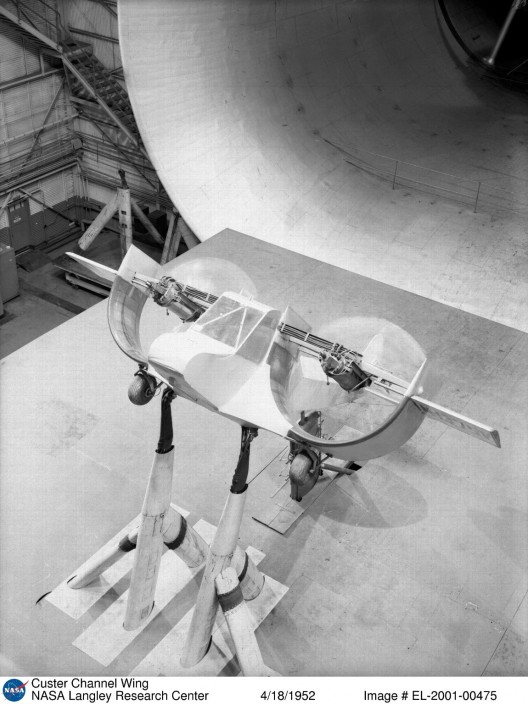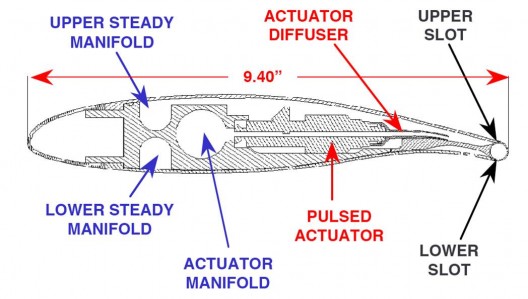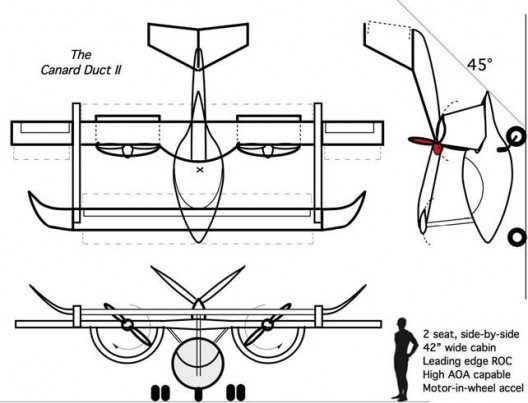Robert J. Englar is Principal Research Engineer at the Georgia Institute of Technology’s Georgia Tech Research Institute in the Aerospace & Acoustics Technology Branch. Responsible for research project direction and development of advanced technologies in aerodynamics, he added a different type of discipline to those presented at the fifth Annual Electric Aircraft Symposium last April in Santa Rosa, California.
His research combines attempts to achieve low noise, high lift and short takeoff and landing (STOL) capabilities while applying pneumatic power to the equation. Not to be confused with inflatable rafts, pneumatic, in this case, refers to the careful routing of high-pressure airstreams over very different airfoil and high-lift device surfaces, and has led to measured coefficients of lift in the 8.5 to 9.0 range. By comparison, a conventional STOL craft may generate a CL of 3.3 (Zenith Air 801) and the Custer Channel Wing claimed, with its propeller blast channeled through a semi-circular wing (hence the name), an infinite CL. Englar is a bit of an evangelist for this one-time discredited aircraft.
Such high lift would enable the ultimate in STOL performance, shortening approach and departure distances, allowing postage-stamp size runways, and reducing infringement on surrounding neighborhoods. Adding electric power to such a vehicle would reduce noise footprints and make Dr. Seeley’s dream of commuter airparks more plausible. Aerodynamically, the high lift would enable reduced wing size, weight, and complexity, according to Englar, on airplanes that would display low-speed safety and control.
Achieving such goals today usually means, according to Englar, using “BIG complex mechanical flaps, slats, spoilers, 4 engines, engine-under-wing hot exhaust on flaps,” and other inelegant denials of the simplicity we’d like to see in mechanical devices.
Englar displayed elliptical airfoil rotor blades, unusual in having rounded trailing edges that nearly matched their leading edges. Combined with circulation control, air under pressure being routed around the trailing edge, these airfoils managed a CL over 6, where conventional rotor blades produced a mere 1.2 to 1.5 at their stall angle.Perhaps even more important than the high lift produced, Englar explains that such blades, with full-span tapered slots blowing on the blades eliminates the need for twist or mechanical angle of attack alpha; and will reduce or eliminate induced drag, plus provide roll and pitch control. A helicopter without cyclic or collective pitch would be enormously simpler than its current equivalent.
This circulation-controlled wing (CCW) works with fixed-wing aircraft, too, giving a 140-percent increase in usable CL, 30 to 35-percent reduction in takeoff and approach speeds, 60 to 65-percent reduction in takeoff and landing ground roll, and a 75-percent increase in liftable takeoff payload over a standard A-6 Intruder – already noted for high-performance takeoffs, landings, and payload capabilities.
The CCW approach reduces parts count over multi-slotted, slatted, and flapped airfoils, eliminates areas of potential failure, and equals or exceeds the performance of those more complex wing systems. Englar promotes the idea of roll control and induced drag elimination through “tailored” circulation control.
A proposed Navy pneumatic channel wing developed in the NASA LARC program and using CCW/USB (upper surface blowing) would be capable of STOL or Vertical STOL flight and perform thrust reversal for dead-stop landings without any moving external wing parts.
Adding pulsed CCW for differential multi-axis control, Englar showed examples of what general aviation aircraft might look like with electric power and CCW, a potent combination for quiet, high-performance flight with simplicity of operation. Such aircraft could reduce mechanical components to a minimum, increasing reliability and safety, and making the true commuter airplane a practical reality.
See the CAFE Foundation’s library for Englar’s paper on super STOL using CCW.




Comments 4
About 50 years ago, there was a prototype that looked quite similar called the “Custer Channel Wing”. I recall one article saying that the entrepreneur behind the project had trouble getting it certified because of single-engine control issues.
If your interested in short takeoff and landing (STOL) , then perhaps the ultimate STOL is a vertical takeoff and landing (VTOL). VTOL “pushes even further the ultimate in STOL performance, shortening approach and departure distances, allowing postage-stamp size runways, and reducing infringement on surrounding neighborhoods.”
For more information, see http://www.Helodyne.com.
(Editor’s note: Your web site tantalizes, but do you have pictures?)
Great article. Very interesting reads.
The illustration showing the wing cross section is a bit confusing. I wish I better understood what the pulsed actuator and actuator diffuser were doing and how the volume of air is directed to and through the “upper and lower slots”.
Re: The channel wing concept. Wouldn’t that be like standing inside a bucket and trying to lift yourself up with the handle?
(Editor’s Note: If the bucket had a high lift airfoil and ample airflow.)